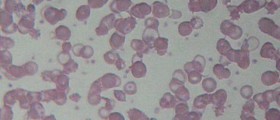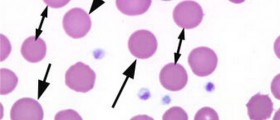
Aplastic anemia is a hematologic disorder characterized by insufficient production of erythrocytes by the bone marrow. Unlike most other types of anemia, when patients only have low count of red blood cells, in case of aplastic anemia, since the bone marrow is the affected organ and the one blamed for inadequate production of all blood cells, it is highly likely to have low white blood cells and insufficient number of platelets too. When all three types of blood cells are insufficient, the person is said to suffer from pancytopenia.Problems with Bone Marrow
There are many different explanations why the bone marrow stops producing optimal number of blood cells and does not release sufficient number of mature blood cells into the blood stream. It is also possible not to identify the underlying cause of such malfunction. This is a so called idiopathic aplastic anemia.
One of the common causes of aplastic anemia is an autoimmune attack of antibodies that simply do not recognize bone marrow cells as a part of one's body but instead they interpret them as foreign objects that require destruction and elimination.
Furthermore, intake of some drugs or exposure to toxins may be a trigger for aplastic anemia. Exposure to benzene as well as intake of chloramphenicol, carbamazepine, phenytoin, felbamate, quinine and phenylbutazone are all examples that may easily initiate failure of the bone marrow and subsequent aplastic anemia.
It is also possible to develop aplastic anemia if the bone marrow has been exposed to uncontrolled ionizing radiation and radioactive materials/ radiation-producing devices.
Aplastic anemia is additionally associated with certain viral infections. For instance, viruses that may affect the bone marrow such as hepatitis viruses, Epstein-Barr and cytomegalovirus are capable of triggering aplastic anemia. The same refers to parvovirus B19 and HIV.
Finally, many health experts have noticed that aplastic anemia may occur in pregnancy and this is connected with an underlying autoimmune disease that has not been diagnosed prior to pregnancy.
Diagnosis of Aplastic Anemia
As it has already been mentioned patients suffering from aplastic anemia have low blood counts of all three types of blood cells i.e. they have pancytopenia. This is what makes the condition different from pure red cell aplasia in which there is only reduction in number of red blood cells.
Once the blood test shows these abnormalities, doctors perform additional tests and exams (e.g. a complete blood count, electrolytes, renal function, liver enzymes etc.). The most important one is bone marrow examination. Biopsy of the bone marrow will confirm the presence or absence of neoplastic infiltration or myelofibromatosis and help doctors rule out certain underlying causes of the disease.
Patients' medical history also plays vital role in diagnosing the condition. Namely, if there is information that patients have been taking some potentially detrimental medications, have undergone chemotherapy or radiation therapy, it will be much easier to confirm the diagnosis of aplastic anemia. Tests such as X-rays, CT scans or ultrasound may point to specific structural abnormalities characteristic for certain conditions associated with aplastic anemia such as Fanconi anemia. Chest X rays may confirm infection, abnormal liver test point to the ongoing liver disease while viral infections are confirmed with viral studies. All in all, a variety of tests need to be performed. Only this way aplastic anemia may be differentiated from other similar conditions and the exact cause of bone marrow failure can be identified.
Management of Aplastic Anemia
In case there is an autoimmune disease, the improvement can be achieved with correct immunosuppression. The immune system may be successfully weakened with daily medicine intake but better results are achieved with a bone marrow transplant. However, transplantation is reserved for advanced stage of the disease when the organ has lost all the ability to produce blood cells. Although transplantation is successful in the majority of cases, there is always a risk of graft failure and graft-versus-host disease, both lethal complications.
Medications that are commonly administered to patients suffering from aplastic anemia include anto-thymocyte globin - ATG (a short course is sufficient enough) or anti-lymphocyte globulin - ALG along with Cyclosporine, a powerful immunosuppressive agent administered for several months. Certain number of patients may respond well to cyclophosphamide and vincristine, both chemotherapeutic agents. Corticosteroids are practically ineffective and are generally used only to bring side effects of other medications under control.
With proper treatment patients enter remission. During this period they are due to undergo regular full blood counts and perhaps additional tests. Some patients may develop one more condition known as paroxysmal nocturnal hemoglobinuria. This medical issue is basically an escape mechanism that develops as a result of damage to the bone marrow caused by inadequate function of the immune system.
All, in all, aplastic anemia is a serious and potentially life-threatening disease. Left untreated, it will definitely cause death within 6 months. With adequate treatment patients may survive the following 5-10 years or even live longer. The best prognosis is in patients who have undergone bone marrow transplantation.

















Your thoughts on this
Loading...